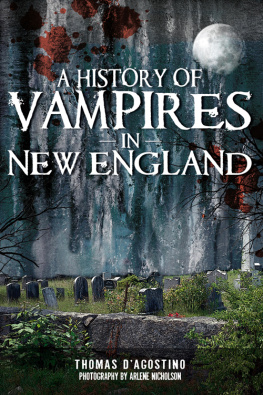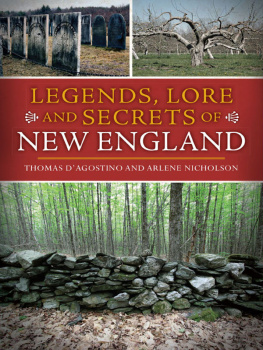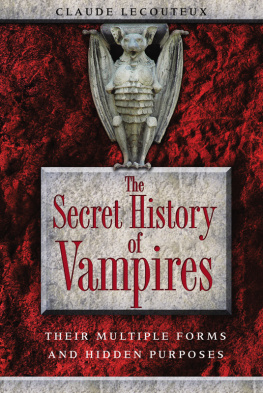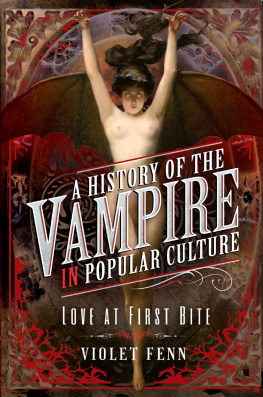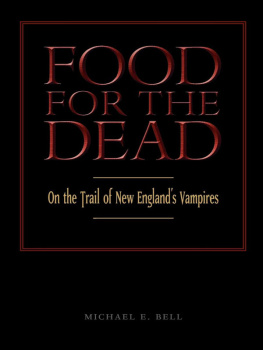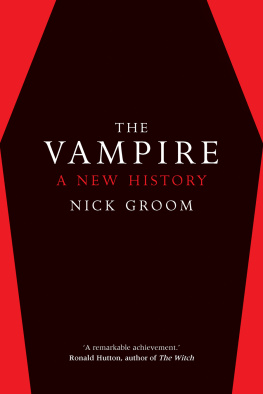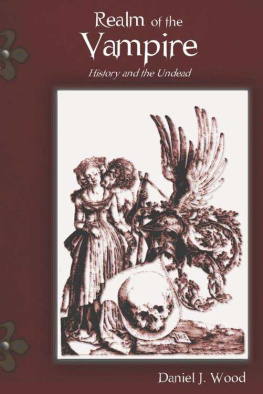A HISTORY OF
VAMPIRES
IN
NEW ENGLAND
A HISTORY OF
VAMPIRES
IN
NEW ENGLAND
THOMAS DAGOSTINO
PHOTOGRAPHY BY ARLENE NICHOLSON

Published by Haunted America
A Division of The History Press
Charleston, SC 29403
www.historypress.net
Copyright 2010 by Thomas DAgostino
All rights reserved
First published 2010
e-book edition 2011
ISBN 978.1.61423.018.2
Library of Congress Cataloging-in-Publication Data
DAgostino, Thomas, 1960-
A history of vampires in New England / Thomas DAgostino ; photography by Arlene
Nicholson. p. cm.
Includes bibliographical references and index.
print edtion: ISBN 978-1-59629-998-6
1. Vampires--New England--History. 2. New England--History. I. Title.
GR830.V3D47 2010
398.45--dc22
2010032462
Notice: The information in this book is true and complete to the best of our knowledge. It is offered without guarantee on the part of the author or The History Press. The author and The History Press disclaim all liability in connection with the use of this book.
All rights reserved. No part of this book may be reproduced or transmitted in any form whatsoever without prior written permission from the publisher except in the case of brief quotations embodied in critical articles and reviews.
CONTENTS
A CKNOWLEDGEMENTS
F irst and foremost, I would like to thank Dr. Michael E. Bell for his incredible research and unending pursuit of the New England vampire. His book, Food for the Dead, has been an immeasurable resource, and his aid and assistance in this book have been equally important. I would also like to thank Christopher Martin, of www.quahog.org, who was instrumental in finding some rare articles and information for this writing, and Mary Deveau, of the Griswold Historical Society, who helped me with the Connecticut vampires. Thanks also go to Mandy Pincins; Justin Badorek; Ron Kolek (the modern-day Van Helsing); Ron Kolek Jr.; Joseph Citro; Dr. Nicholas Bellantoni; Jeff Belanger; author Christopher Rondina, who has spent years researching and writing about vampires; Carol Lyons of the Foster, Rhode Island Town Hall; noted Rhode Island historian Edna Kent; the Greenville Public Library; the Putnam Public Library; the Tyler Free Library in Foster, Rhode Island; the Providence Public Library; the Town of Dummerston, Vermont; Lori and John DaSilva; the Otis Free Library; the Providence Journal Bulletin; Anthony Dunne of WGBY; Rhode Island PBS; Joe Nickell; and everyone who wished to remain anonymous but were instrumental in the creation of this book.
I NTIODUCTON
O f all the creatures in history, the vampire is perhaps the most enigmatic. Scores of books, movies and television series have bestowed upon this being many guises, from hideous and grotesque to charming and gentleand sometimes even comical. The New England vampire was, in its own right, a whole different character than what we have seen in film or print. In the events that took place during the eighteenth and nineteenth centuries, the vampire of New England took on a role as a spiritual being rising from the grave to feed on the living.
The disease then known as consumption and now known as tuberculosis was sending family members one by one to the tomb. There was no cure at the time, and where medicine failed, folklore took over. At the time, the word vampire never crossed the lips of these fearful citizens, at least not loud enough for anyone to hear. The living were convinced that the spirit of one of their recently deceased was rising from the grave to feed on family members, thus spreading the dreaded disease from one person to the next. Most New England families were inclined to believe that the spirit fed only on family members, afraid of being discovered. In some cases, families lost up to five members within the span of a year. Other cases show that consumption claimed the mortal frames of loved ones over a period of several years or perhaps decades. One must figure, however, that if a family lost three or four members in the course of several years, it would have been devastating.
Scores of families began exhuming their loved ones in search of the devils concubine among them that was mercilessly sapping the life from them. They looked for certain telltale signs that would convince them that a vampire was at work. Among those signs was a bloated body, signifying that the spirit had recently fed. Blood around the mouth was also a mark of a recent nightly visit. Other indications were hair and fingernails that appeared as if they had grown, pale flesh, a body in little or no state of decay and perhaps even movement within the coffin. The heart was usually removed from the corpse and cut open. If fresh blood dribbled from the organ, it was known beyond the shadow of a doubt that the vampire had been found.
The most common practice of New England exorcisms for vampirism consisted of removing the heart, liver and lungs, burning them and feeding the ashes to the inflicted, mixed with some sort of medicine or water, as a remedy for their illness. Sometimes other forms of exorcism were instituted, as you will soon read.
Today, it sounds quite unreasonable for such rituals to take place, but we must keep in mind the fact that families were literally being wiped out by the dreaded consumption. In some cases, neighbors feared that the vampire would soon prey on them when the last of its kin was gone.
As you read these pages, you will find that the New England vampire was also quite an enigma. Many of the accounts are well documented and available for the interested to peruse. Others are extremely vague, and most of the graves are no longer in existence or are marked with fieldstones in a family plot, making it difficult to pinpoint who is buried where. Our research and investigations of these burial yards, based on what little we had to go on, proves that many times family members succumbed to consumption in rapid succession. Often, the family was forced to make hand-hewn stones out of fieldstone to serve as markers until more proper stones could be procured, sometimes years later, if at all. Money was also an issue when a proper stone was to be made, as the devastation of the disease left most families financially wrought, especially when the patriarch of the clan, who may have run a skilled business, passed unexpectedly, leaving a widow to tend to the farm or business.
When Obidiah Higginbotham of Pomfret, Connecticut, died in 1803, his wife, Dorcas, had to sell what she could to pay their debts, including land and possessions. Obidiah ran a small business, the Higginbotham Spinning Wheel Company, on the Nightingale Brook that ran behind the home. The family continued to make the wheels, as Darius Higginbotham had learned the trade. Men taught their young the tricks of their trade early so that they might someday inherit the family profession or become self-sufficient.
In rural New England, fieldstone markers were quite common in early burials. Wood was also used. Some markers bear a roughly carved inscription, while others are plain slates marking the final vestiges of ones tenure on this earth.
Contained within these pages are various cases of the history of the New England vampire as best we know it. These are by far not the only instances of exorcism for vampirism. Scholars have concluded that many more exorcisms went on undocumented. This is a chapter in New England history that has made for many scary tales, best told when the moon is full and the coyotes howl in the distance.
Next page
